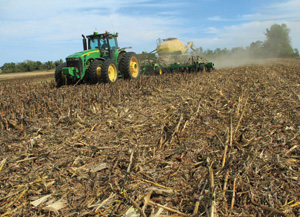
Wheat field unharvested
Article taken from https://agcrops.osu.edu/newsletter/corn-newsletter/2024-25/2024-ohio-wheat-performance-test-results-available-online by Laura Lindsey, Matthew Hankinson
Results from the 2024 Ohio Wheat Performance Test are now online by clicking here. This year’s report includes 84 winter wheat varieties and 17 brands grown in five counties (Wood, Wayne, Darke, Union, and Pickaway) (Figure 1).
In fall 2023, wheat was planted within 14 days of the fly-free date. Fall growth was good, and wheat entered dormancy in great condition. Higher than normal growing degree days in March through June accelerated crop development. Wheat was harvested about 10 days earlier than normal, with harvest dates ranging from June 18 in Pickaway County to July 2 in Wayne and Darke County. Overall, wheat yield was lower than the previous year, likely due to higher levels of disease and shorter grain fill period. In 2024, average grain yield across the five counties was 83 bu/acre (90 bu/acre average high and 75 bu/acre average low). In 2023, the average yield across locations was 108 bu/acre (117 bu/acre average high and 95 bu/acre average low).
Figure 1. The 2024 Ohio Wheat Performance Test was conducted in five counties and included 84 winter wheat varieties.
The purpose of the Ohio Wheat Performance Test is to evaluate wheat varieties, blends, brands, and breeding lines for yield, grain quality, and other important performance characteristics. This information gives wheat producers comparative information for selecting the varieties best suited for their production system and market. Varieties differ in yield potential, winter hardiness, maturity, standability, disease and insect resistance, and other agronomic characteristics. Selection should be based on
 📬 The 2025 Northwest Ohio Newsletter is Coming!
📬 The 2025 Northwest Ohio Newsletter is Coming! OSU Extension invites crop producers, CCAs, and agribusinesses to attend a regional at the Fall 2024 Ohio State Weeds University on Thursday, November 21, 2024, from 9:00 am to 4:00 pm. The program will take place at locations across the state. Locations include Darke, Highland, Sandusky, Licking, Paulding, and Mahoning counties. This program is designed to keep agronomic crop producers on the cutting edge of weed control for their operations. Topics addressed will include preharvest weeds survey results, drone applications of herbicides, burcucumber control, new herbicides, and new technology in weed science. Hands-on exercises such as weed ID with live plants will also be part of the program and tailored to local needs. This is an in-person event with a portion of the presentations being broadcast virtually at each regional location.
OSU Extension invites crop producers, CCAs, and agribusinesses to attend a regional at the Fall 2024 Ohio State Weeds University on Thursday, November 21, 2024, from 9:00 am to 4:00 pm. The program will take place at locations across the state. Locations include Darke, Highland, Sandusky, Licking, Paulding, and Mahoning counties. This program is designed to keep agronomic crop producers on the cutting edge of weed control for their operations. Topics addressed will include preharvest weeds survey results, drone applications of herbicides, burcucumber control, new herbicides, and new technology in weed science. Hands-on exercises such as weed ID with live plants will also be part of the program and tailored to local needs. This is an in-person event with a portion of the presentations being broadcast virtually at each regional location. While you are harvesting or hanging out in the shop, join our OSU Extension Farm Management team on October 18 at 7:30 AM ! Listen in on Zoom.
While you are harvesting or hanging out in the shop, join our OSU Extension Farm Management team on October 18 at 7:30 AM ! Listen in on Zoom.


 LONDON, Ohio – More than 50 companies will join the ranks as exhibitors for the 61st Farm Science Review Sept. 19-21 at the Molly Caren Agricultural Center. The new exhibitors represent various sectors in the agriculture industry including livestock handling, equipment advancements, agronomic technology, agricultural policy, and more.
LONDON, Ohio – More than 50 companies will join the ranks as exhibitors for the 61st Farm Science Review Sept. 19-21 at the Molly Caren Agricultural Center. The new exhibitors represent various sectors in the agriculture industry including livestock handling, equipment advancements, agronomic technology, agricultural policy, and more.
 Join the Digital Ag Team as they dive into research results from around the state of Ohio based on the 2021 eFields report. Registration is free but required. Have you been enjoying the 2021 fields Report and are excited to learn more? Join us to learn more about the eFields program and the results we are seeing across the state.
Join the Digital Ag Team as they dive into research results from around the state of Ohio based on the 2021 eFields report. Registration is free but required. Have you been enjoying the 2021 fields Report and are excited to learn more? Join us to learn more about the eFields program and the results we are seeing across the state.

 lication for the 2021 Ohio Wheat Performance Trials has been finalized and is attached as a PDF file. This article will be published in the mid-August issue of the Ohio Country Journal. All of these results are also available online at the wheat performance trials website:
lication for the 2021 Ohio Wheat Performance Trials has been finalized and is attached as a PDF file. This article will be published in the mid-August issue of the Ohio Country Journal. All of these results are also available online at the wheat performance trials website:  By Jason Hartschuh, OSU Extension Educator, Crawford County
By Jason Hartschuh, OSU Extension Educator, Crawford County




 By Mark Loux, OSU
By Mark Loux, OSU
